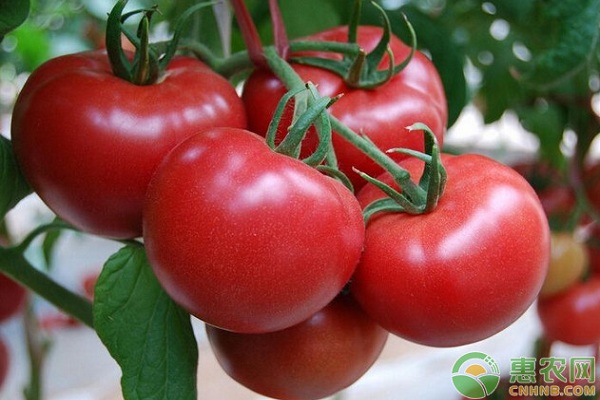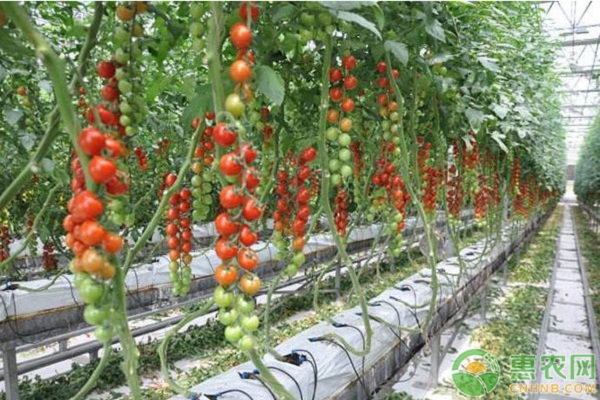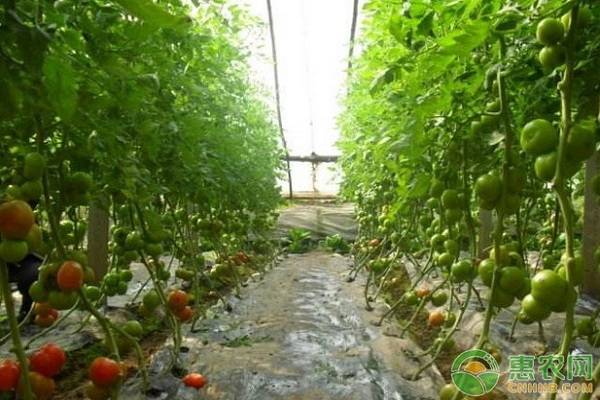The tomato powder 318 tomato variety is a tomato variety selected by Tianjin Agricultural Biotechnology Research Center. It is characterized by strong growth potential, early and middle maturity, and good fruit set in succession. It is suitable for greenhouse cultivation in autumn and winter. Let's learn about the high-yield cultivation techniques of Tianjin powder 318 tomato greenhouse in autumn and winter.

1 sowing seedlings
1.1 sowing seedling time
The greenhouse cultivation in autumn and winter should be planted from July 10th to July 20th, and the planting time is between August 10th and August 20th.
1.2 seedbed preparation
Seedlings were seeded in 72-well trays. The ratio of the seedling substrate formula is peat.. vermiculite: perlite is 3 .. 1 .. 1. 50% carbendazim WP or 70% thiophanate-methyl WP 200 g and 3% phoxim granules 200 g were added per 1 m 3 of matrix. After the matrix is ​​mixed, it is first piled up, covered with plastic film and covered for 7 days, and then the film is uncovered, and the disk is discharged after the gas is exhausted. The product seedling substrate can also be used, and the seedbed is leveled in advance, and the tray is filled with the substrate and laid on the surface.
1.3 sowing
Before sowing, first pour water through the water, soak the water after soaking, the soil covered with soil about 1 cm, can not be too thin, otherwise the seedlings are easy to wear hats, can not be too thick, affecting the seedlings after unearthing, spraying after the soil 1 Sub-permeable.
1.4 Seedling management
1.4.1 Temperature Management
The seedling period is in the high temperature season, it is necessary to strengthen the ventilation and cooling of the nursery site, and take measures such as covering the sunshade net to reduce the temperature in the high temperature stage at noon on sunny days.
1.4.2 Water and fertilizer management
After sowing, one must maintain sensation, prevent soil from drying out and affect emergence. In the process of seedling growth, depending on the growth of the soil and seedlings, the water should be replenished in time to see the wetness and prevent the lengthening. In the process of nursery, it is forbidden to apply nitrogen fertilizer at the seedling stage to avoid the influence of seedling growth on flower bud differentiation. When the seedlings grow out of the true leaves, they are combined with watering, and 0.1% water-soluble compound fertilizer is added to the water to supplement the nutrition.
1.4.3 Pest Control
The whole seedling period should pay attention to pest control and disease prevention. The pests are mainly whitefly, whitefly, and aphids. Before planting, the insects are used to kill insects around the nursery. The nursery field is isolated by a 60-mesh insect net, and timely detection and control is carried out when the pests are found. Whitefly can be sprayed with 22% Teflon 1500 to 2 000 times or 0.6% fine powder 500 times. Aphid can be 10% imidacloprid 1 000 ~ 1 500 times or 25% Akthai water dispersion granule 3 1000 times liquid control; the disease is mainly rickets and blight, after the seedlings are out, use 72.2% Plex water 600 times solution or 30% carbaryl water agent 1 000 times liquid spray to prevent and control the drug flow To the roots.

2 colonization
2.1 Preparation before planting
2.1.1 Fertilization and soil preparation
5 000 ~ 7 500 kg of fertilized organic fertilizer per 667 m 2 , 50 kg of high potassium compound fertilizer, 40 kg of superphosphate, 5 kg of magnesium sulfate, 1 kg of zinc fertilizer and boron fertilizer, and 30-40 kg of biological fertilizer. After fertilization, the sputum is flat and fine. It is cultivated with sorghum, with a width of 1 m, a groove width of 0.5 m and a groove depth of 15 to 20 cm.
2.1.2 Covering the shade net
Before the planting, the greenhouse film is covered with a sunshade with a light transmittance of 50% to 70%.
2.1.3 Covering insect nets
Before the planting, cover the 40-mesh insect net at the tuyere to prevent pests.
2.2 colonization
Tomato seedlings colonize when they grow to 4 leaves and 1 heart. Choose to plant in the sunny afternoon to prevent sun exposure after planting. Before planting, the roots were planted with 30% carbendazim 500 to 1 000 times, and planted immediately after planting. The plant spacing was 35-40 cm, the row spacing was 60 cm, and 2 200 ~ 2 500 plants were planted per 667 m 2 . The depth of planting can be buried in the height of the substrate, and watered in time after planting.
3 Field management
3.1 Temperature Management
Temperature management adopts a method of pre-control. After the planting, the temperature is high in the early stage. The sunshade net should be covered at high temperature every day at noon. The maximum air volume should be ventilated throughout the day. The maximum temperature in the greenhouse should not exceed 34 °C. The temperature during daytime control is controlled at 25 to 28 °C and 15 to 18 °C during the night. After entering the first half of September, the temperature gradually decreased, and when the daytime temperature dropped below 30 °C, the sunshade net was removed. The mulch is covered in the middle and late September. When the minimum outside temperature drops to 12 °C, close the tuyere; when the minimum temperature drops to 8 °C at night, cover the insulation at night. Temporary warming equipment should be used at the extreme temperature in winter.
3.2 Water and fertilizer management
After planting for 5 to 7 days, pour 1 time of slow seedling water, soak the seedling water, and then seedling. If the leaves appear wilting at noon during the seedlings, they should be poured in time. When the first ear of the plant grows to the size of the walnut, watering and fertilization are started. Apply water-soluble high-potassium compound fertilizer 15 to 20 kg per 667 m 2 , and then keep the soil moist, and apply the principle of top dressing for one ear. It is advisable to water the water in the winter with a small amount of water. It is important to remember that the ground temperature caused by flooding has dropped sharply. Watering should be done on a sunny day and ensure that there is 3 to 4 days after the watering. In order to prevent premature senescence in the middle and late stages, foliar spray fertilizer can be used with 0.2% to 0.3% potassium dihydrogen phosphate.
3.3 Lighting Management
After entering the end of October, there are more cloudy and smoggy weather, adding plant fill light in the shed or hanging the reflective screen on the back wall of the shed. In the winter, the insulation is removed in time, and the indoor temperature is not lowered. The coverage time is preferably 17 °C. In the case of temperature permitting in the winter, it is necessary to insist on uncovering the insulation and making full use of the scattered light.
3.4 Plant adjustment
Using a single dry pruning method, each plant leaves 4 to 6 ears of fruit topping, leaving 3 to 4 fruits per panicle, and knocking out the first flower of each panicle. Topping should leave 2 leaves in the upper part of the last spike to ensure nutrient supply to the ears. Pruning must be done on a sunny day. In the later stage of plant growth, the old leaves of the lower part of the plant should be removed in time to improve the ventilation and light transmission conditions.
3.5 flower protection fruit
The artificial fruit-assisted method is used to preserve the fruit, and the fruit is taken at 80% of the recommended dosage of the flower stalk; or the bumblebee is used for pollination. When the flowering number of the tomato plant is about 20% or more, it is placed in the greenhouse, and one box is placed per 667 m 2 area.
4 Pest control
The prevention and control of pests and diseases should be based on prevention and comprehensive prevention.
4.1TY virus disease
The main mediator of TY virus disease is B. tabaci, so it is necessary to strictly control B. tabaci, cut off the route of transmission, and once the diseased plant is found to be pulled out in time. At present, there is no specific treatment for the treatment of tomato TY virus disease, but it can be sprayed before the onset of the disease, spraying 2% of the bacteria gram gram 700 to 1 000 times solution, or 20% virus A WP 500 times solution spray control Spray 7 times for 7 to 10 days and spray continuously for 2 to 3 times.
4.2 Gray mold
Use 25% ampicillin suspension 1 500 times solution, 50% Kaiser water dispersion granule solution 1 000 times liquid spray control, or use 38% gray nucleus smoked smoke agent for smoking shed, use every 667 m 2 200 to 300 g, once every 7 days, for 2 to 3 times.
4.3 leaf mold
Use 47% Chunlei·Wang copper wettable powder 800~1000 times liquid, or 75% chlorothalonil wettable powder 600 times liquid spray control, spray once every 7 days, and spray 3 times continuously.
4.4 Gray leaf spot
In the early stage of the disease or before the onset, use 77% to kill the wettable powder 400 ~ 500 times solution, or 25% Amishida suspension 1 500 times spray control, 7 ~ 10 d spray once, continuous spraying 2 ~ 3 times.
4.5 night blight
25% amoxicilin suspension can be used, 1 000 to 1 500 times solution, or 52.5% anti-fast WP 2 500 times solution spray, 7 days spray, continuous spraying 2 to 3 times. In the prevention of spraying, it is important to spray 5 to 6 strains at the southern end of the greenhouse. When spraying, it is important to spray the diseased plants and surrounding plants.

4.6 early blight
In the early stage of the disease, 40% Shijiale Suspension 700 times solution + 64% antivirus WP WP 500 times solution, 70% Mancozeb WP 500 times solution spray, 75% chlorothalonil WP 600 times solution spray , 7 d spray once, continuous spraying 2 to 3 times.
4.7 Bemisia tabaci, whitefly
It is necessary to take measures such as covering the insect net and hanging the yellow board. The upper and lower air outlets should cover more than 40 mesh insect nets to prevent the whitefly from migrating from the outside to the greenhouse; according to the strong tendency of the whitefly to yellow, use the yellow plate to trap the adult, 40 pieces per 667 m 2 and operate simultaneously. Place 2 pieces between each other. In the early stage of the chemical control, in the early stage of B. tabaci and B. tabaci, use 25% Akthai water dispersible granules 3 000 times solution, 25% buprofezin emulsifiable concentrate 1 000 times liquid spray, or Iso Wei smoke agent per 667. m 2 250 ~ 300 g each time.
The above is all the contents of today. I don't know if any tomato growers have contacted this tomato variety. Does anyone have any comments?
Guangzhou Zhongzhinan Supply Chain Co.,Ltd. , https://www.gzzhongzhinan.com